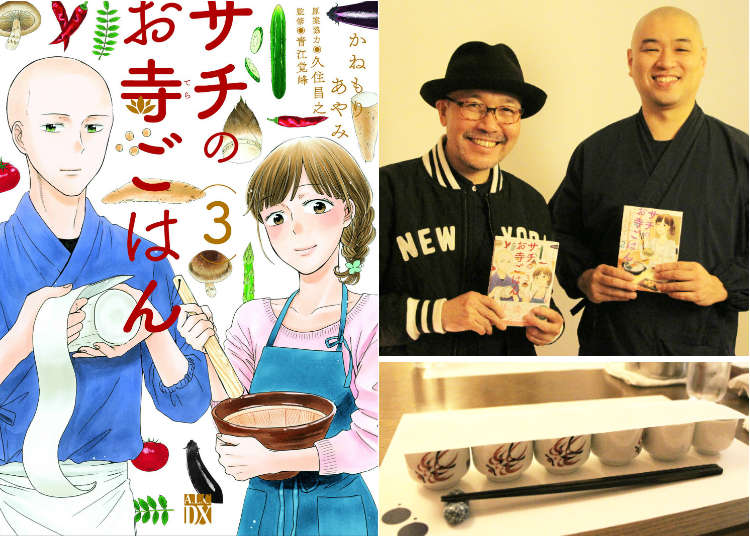
In 2013, Japanese cuisine was officially made an UNESCO Intangible Cultural Heritage. The Ministry of Agriculture, Forestry and Fisheries lists four distinctive characteristics on its homepage that an authentic Japanese dish has to have:
1. A high regard for the unique tastes of diverse and fresh ingredients
2. A nutritious and well-balanced composition to promote and support healthy eating
3. An expression of the beauty of nature and the four seasons
4. A close connection to annual events and festivities, such as New Year’s
Using seasonal ingredients and making use of their unique characteristics – isn’t the elegant simplicity of Japanese cuisine that works entirely without any kind of flashiness representative of the Japanese spirit itself?
The topic of washoku, Japanese cuisine, has also made its way into Japanese pop culture by becoming the main theme of various manga. One of them is “Sachi no Otera Gohan,” or “Sachi’s Temple Food” created by Ayami Kanemori in cooperation with Masayuki Kusumi (left) and supervised by Kakuho Aoe (right), published by Akita Shoten.
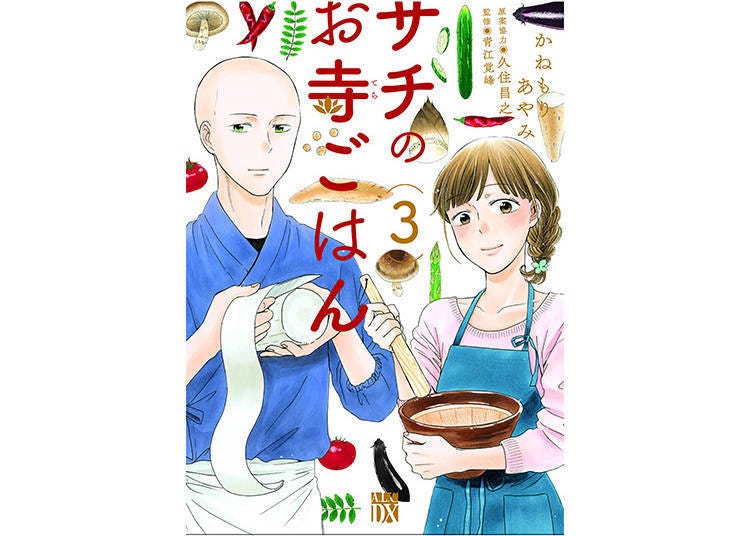
Sachi no Otera Gohan deals with a type of Japanese cuisine that hardly comes up even in the genre of gourmet manga: shojin ryori, a vegetarian cooking style that can be called Buddhist temple cuisine. The main protagonist Sachi Usui is named after the Japanese expression “sachi ga usui,” referring to someone who is unlucky without any particular reason. The story follows her as she meets a Buddhist monk and the people surrounding him, and Sachi starts to learn about shojin ryori and the broader Japanese cuisine.
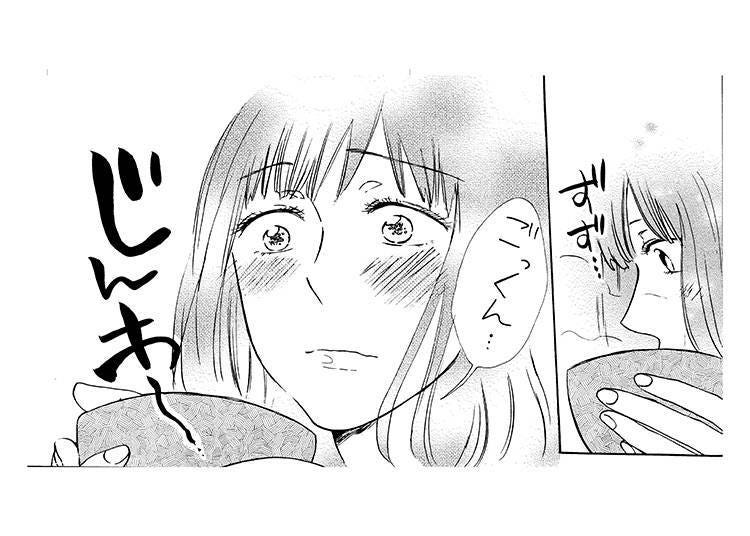
Dashi, a Japanese soup stock, and its importance plays a big role in this manga. In its very first chapter, Sachi buys a bento, a boxed lunch, at a convenience store and starts opening her eyes to how delicious authentic Japanese cuisine is. The first dish to appear is a soup called rikyu-jiru, made from soy bean dashi.
If you already know what dashi is, you’ll likely think that it is made from kelp and bonito. The world of dashi is by no means a small one, however – the example in the first chapter shows that it can be made from soy beans, while a dish from the fourth chapter features dashi made from corn cob. Gendo, the chief priest who introduces Sachi to the world of Buddhist cuisine, explains that “dashi can be made from almost any vegetable skin or peel that remains after cutting.” So yes, there is a large variety of dashi, used in accordance with the dish that is to be made. This might be just one of the reasons why it’s often said that “Japanese cuisine is subtle.”
The work that illustrates the importance of dashi for Japanese cuisine, Sachi no Otera Gohan, has just released its third volume that is on sale in Japan since November 18th. To celebrate this new release, a “Dashi Tasting Event” has been held – and we were part of it! The mangaka herself, Ayumi Kanemori was present, as well as the original creator of the idea for Sachi no Otera Gohan, Masayuki Kusumi. Of course, the head priest of Yushima’s Ryokusen-ji Temple called Kakuho Aoe who is also referred to as “the cooking monk” and strives to educate people about food, also took part in the event. Let’s have a closer look at the amazing evening!
Ready, Set, Go – The Dashi Tasting!

Sachi no Otera Gohan’s publishing event was held at the restaurant “Asakusa Oto” that just opened two years ago. It is located just a ten-minute walk away from one of Asakusa’s most famous sightseeing spots, Kaminarimon. With its wonderfully calm atmosphere, it was just the right place to pay homage to dashi and Buddhist cuisine!
There were six small cups arranged in front of every guest, filled with soups that got thinner and clearer by the cup. Before we got to the tasting, though, the supervisor of Sachi no Otera Gohan and head priest of Ryokusen-ji, Kakuho Aoe, explained to us mildly confused guests: “Today, we’ll enjoy six dishes that are made with dashi but before that, I’d like you to try these six dashi and guess what ingredients they were made of.”
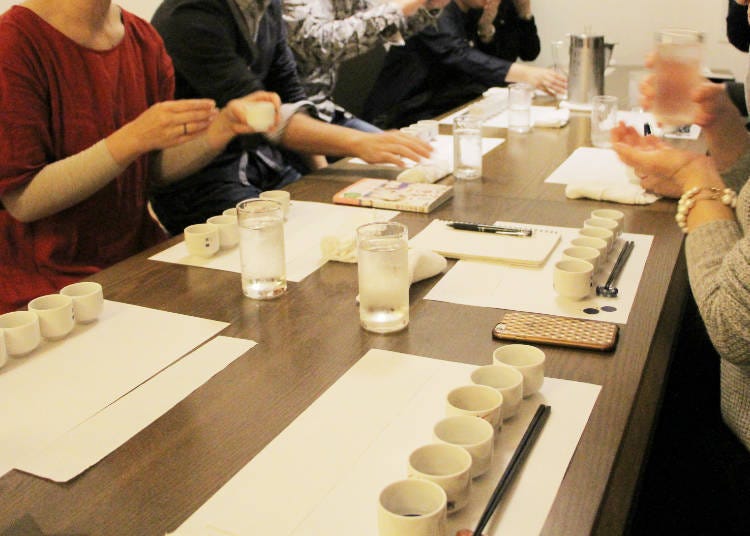
With the very first sip, a pleasant, delicious flavor spread evenly on the tongue and throughout the mouth. For the first three, guessing the ingredient turned out to be relatively simple: familiar flavors such as kelp, bonito, and soy bean immediately came to mind. The remaining three dashi cups, though? They certainly tasted amazing but naming what ingredient they were made with was quite impossible.
It was chicken, nori, and clam. All of these ingredients are rather standard and often used in all kinds of cuisines, particularly the Japanese – maybe almost too common as we don’t seem to consciously taste them in our day to day meals.
Buddhist Cuisine: Subtlety is Key
Just after everyone finished sipping their dashi cups – and getting about half of them right – the cooking monk Kakuho Aoe explained the connection between dashi and shojin ryori, Buddhist cuisine.
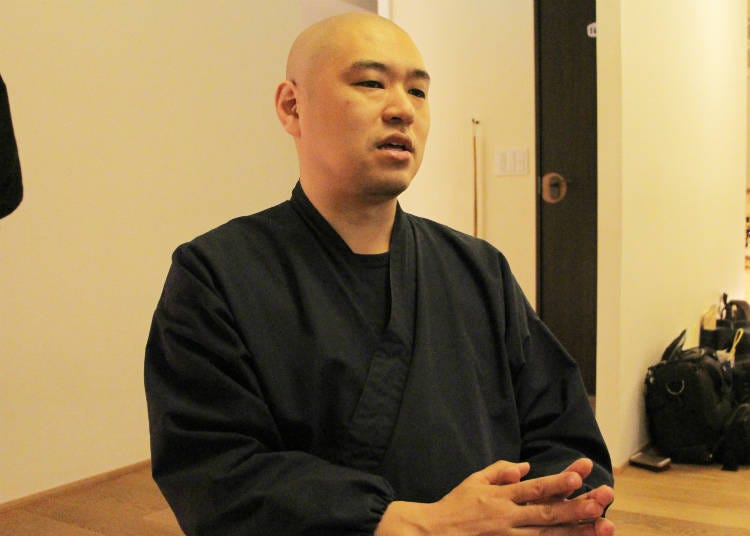
“In shojin ryori, nothing is wasted. The ingredients from which the dashi is made are also finely chopped to be used in the dish. Also, food is based on ‘gomi’ [five flavors; sweet, sour, salt, bitter and pungent], and ‘tanmi,’ [the subtle flavor], is the sixth flavor that makes Buddhist cuisine what it is. This subtlety means making use of the ingredient’s own taste without seasoning it more than necessary. This way of thinking of Buddhist cuisine is also the foundation of washoku [Japanese cuisine].”
Let nothing go to waste and making use of the ingredients – this way of thinking is also illustrated in Sachi no Otera Gohan. A good example of this can be found in the ninth chapter which revolves around a dish called hirosu, made from vegetable leftovers that others would throw in the trash. While many people do seem to understand the potential value of stuff that is thrown away, almost no one actively tries to let no single part go to waste. Shojin ryori places value on things that are all but forgotten in modern daily life.
Six Dishes, Made with Six Kinds of Dashi!
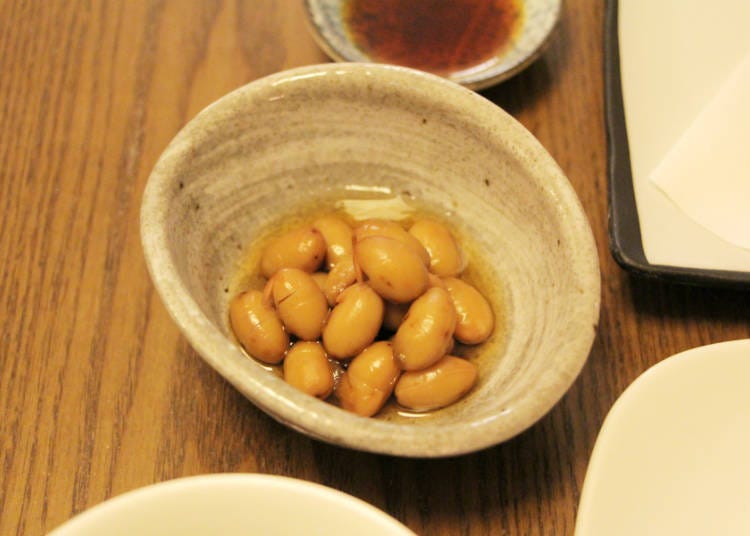
・Nimame, Boiled Beans – Soy Bean Dashi
An amazingly simple yet delicious dish boiled in soybean dashi. These beans appeared in chapter 13 of Sachi no Otera Gohan and dazzled the heroine with their rustic taste. The taste of the soybeans is incredibly rich and sure to leave everyone more than satisfied.
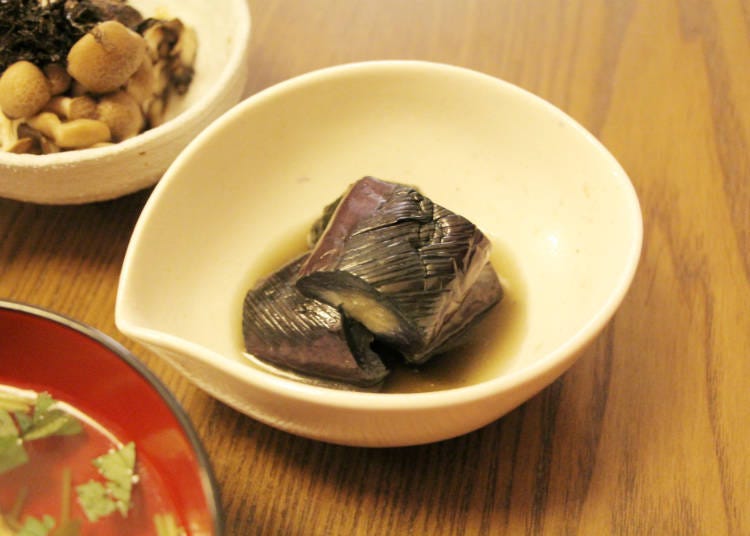
・Fried Eggplants on Vinegar – Kelp Dashi
This is a dish from chapter 17. The thick eggplant slices condense the taste of the vinegar, getting more delicious with every single bite. The rough texture of the dish goes amazingly well with its juiciness.
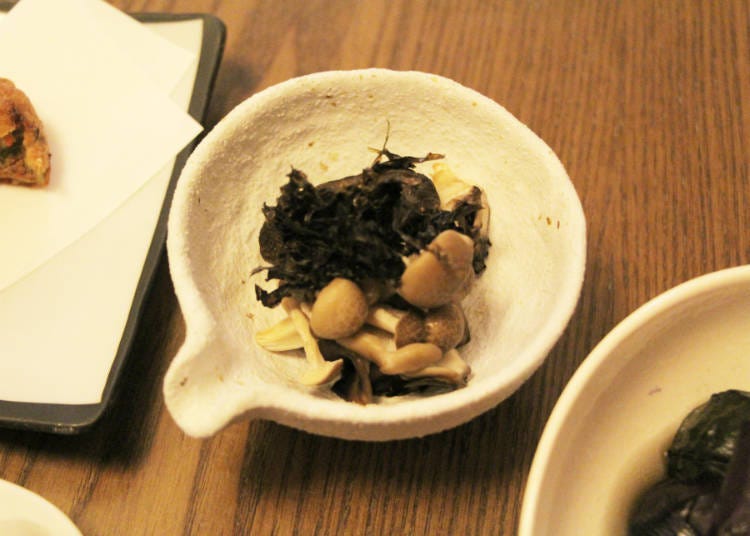
・Mushrooms with Nori Seaweed – Nori Dashi
Having appeared in chapter 8, this simple dish can be made in ten minutes! The seaweed matches the taste of the mushroom just perfectly and a dash of citrus gives the creation a very refreshing.

・Hirosu – Bonito Dashi
Hirosu is a dish from chapter 9 that is made with chopped vegetables, tofu, and Japanese yam. This delicious mixture is then fried. The outside is pleasantly crunchy while the inside is amazingly fluffy. In the manga, hirosu is made with vegan dashi from Buddhist cuisine but for the event, we got to try a version made with Asakusa Oto’s bonito dashi.
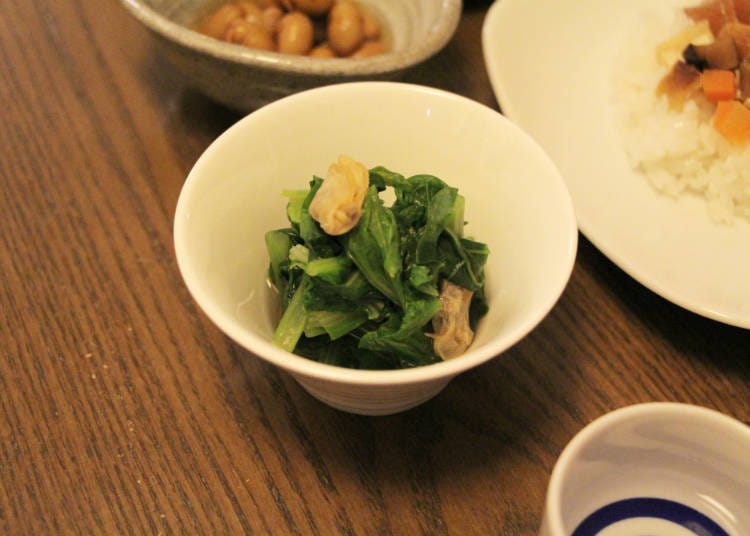
・Ohitashi with Clam and Greens – Clam Dashi
This dish, called ohitashi, is made with Tokyo-style vegetables, namely a type of spinach called norabona, as well as a cabbage-like green called shintorina. Aside from dashi, the vegetables are lightly seasoned with soy sauce and mirin. The fresh crispiness makes this ohitashi particularly delicious!
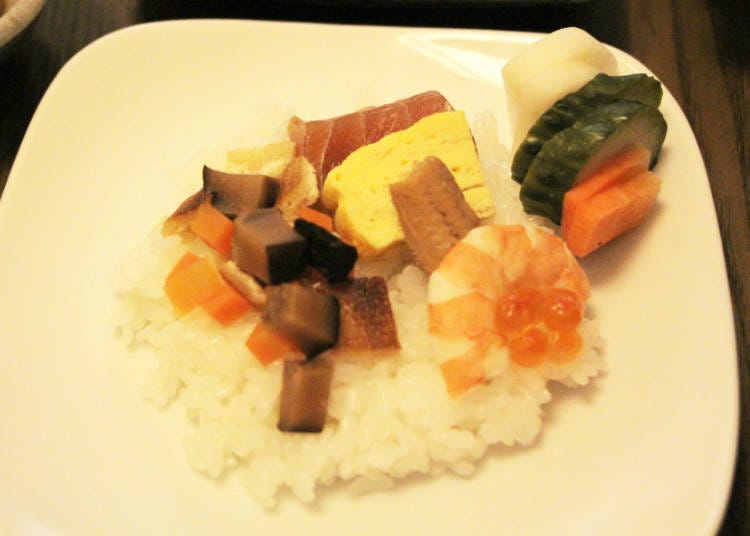
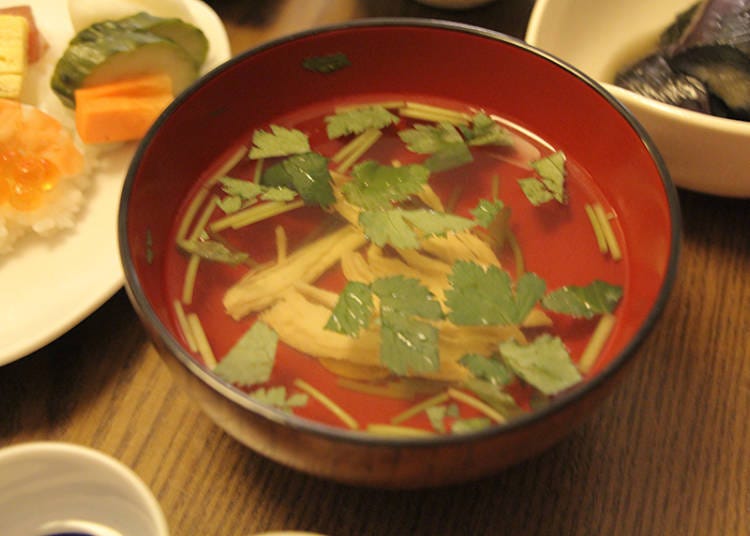
・Clear Chicken Soup and Higanzushi
Higan is the term for the equinoctial week when the day is exactly as long as the night and higanzushi is a sushi style that uses exactly as much vegetables as it uses fish and seafood – this dish also appeared in chapter 12 of Sachi no Otera Gohan. As everyone continued to eat, they discovered a huge variety of flavors: ingredients from Buddhist cuisine alongside thin omelet, tuna, and shrimp – the coloring of the dish is also extremely beautiful. Aoe-san explains that the relatively wild composition of ingredients represents human lifestyle. The clear chicken soup is lightly seasoned with mirin and soy sauce and warms from inside.

As we tasted the food, we also learned that the chefs of Asakusa Oto shave the dried bonito flakes used for seasoning themselves. Generously spread over dishes, they are pleasantly rich in fragrance and their flavor spreads from the nose to the mouth with one single bite. This kind of gourmet sensation cannot be enjoyed with powder or a retort.
In recent years, Japanese cuisine has attracted international attention and more and more people from outside of Japan seem to be interested in dashi culture and its unique tastes, says Yoshiki Hatani, the owner of Asakusa Oto.
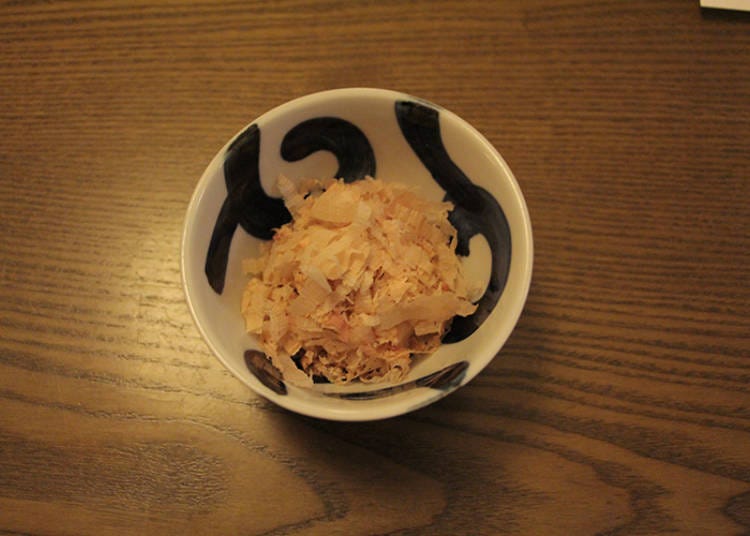
“Tourists always seem to find the bonito flakes a bit weird. ‘What are these brown things?’ they wonder. Some also keep staring at the freshly shaved bonito flakes.”
As we talked about dashi, Kanemori-san, the mangaka of Sachi no Otera Gohan, remembered an anecdote from her own life.
It turned out that her mother actually was an amazing cook and she herself likes cooking a lot as well. She said that she was trying her hand at making miso soup from dashi herself since middle school. Afterwards, she started working on gourmet manga and for now, she cooperates with Kusumi-san but says: “I definitely want to try making one by myself as well.”
“In a gourmet manga, the food needs to look delicious”, says Kusumi-san. “But this is often hard to pull off because Japanese manga are black and white.” When looking at Sachi no Otera Gohan, however, the dishes definitely look very mouthwatering, and this is probably due to the fact that Kanemori-san actually makes all of them. She cuts the ingredients, carefully prepares them, and then finishes the dish. Experiencing this sequence for yourself is likely needed to convincingly express the feelings of making food in only a few panels.

Lastly, Kusumi-san passionately talked about Japan’s food culture.
“Japanese people freely use all kinds of cutlery when eating, be it chopsticks, forks, or knives. Even when they start living alone for the first time as college students, they have all kinds of tableware. Because of this reason alone, they’re all interested in food. Besides that, Japanese people like to eat something different every day. Ramen yesterday, pasta today, buckwheat tomorrow – food variation is very important.
Because no matter what kind of city or village you go to, you’ll always find a variety of delicious restaurants serving Japanese cuisine, Western dishes, or ramen, I feel that Japanese people really have a passion for food.”
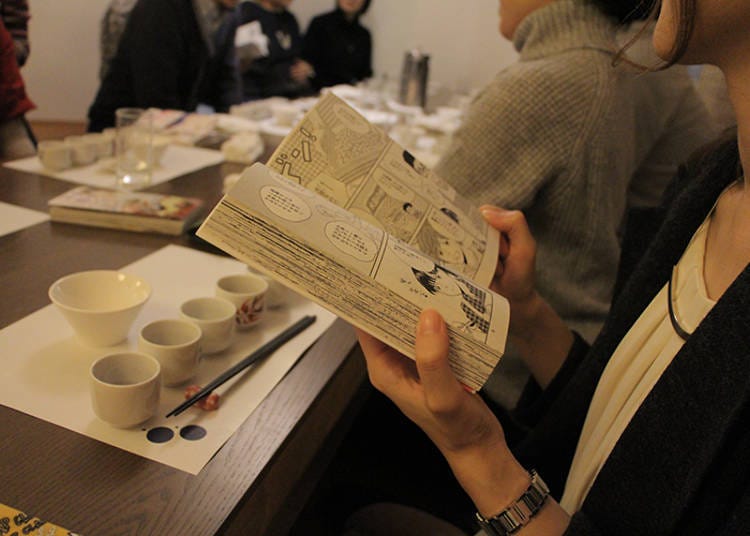
In Japanese cuisine, dashi is an important and indispensable part – the publishing event of Sachi no Otera Gohan’s third volume illustrated this very vividly and very deliciously. Just like its heroine Sachi, all the participants seem to have opened their eyes about Japanese and Buddhist cuisine a bit more as they tasted the amazing dishes, and are maybe looking at it differently from now on.
Incidentally, the manga Sachi no Otera Gohan also includes the recipes of all the introduced dishes – so if looking at them gets you hungry, go ahead and try your hand at making them yourself at home! And why not regard the gourmet experience as a way to train your mind and body, too?

Dai Igarashi
I am a freelance writer and editor born in ’83. My hobby is to loaf around while reading manga. From survival and death game to adorable shojo, I enjoy all kinds of genres.
- Area
- Category
*Prices and options mentioned are subject to change.
*Unless stated otherwise, all prices include tax.
Popular Tours & Activitiess
Recommended places for you
-

NIHONRYOURIJAPANIHZUKYUIJIHNUSAKURAGAOKA
Japanese cuisine
Shibuya
-

Oto-Oto Ikebukuro
Japanese cuisine
Ikebukuro
-
Menu

Ganso Kamameshi Haru
Japanese cuisine
Asakusa
-

Kurayamizaka Miyashita Marubiru
Japanese cuisine
Tokyo Station
-

Nichigekka Ginza
Japanese cuisine
Ginza
-

Tokyosumomatsuri
Japanese cuisine
Ginza
-

2025 Autumn Colors Report: Kurobe Gorge Nearing Peak
by: Timothy Sullivan
-

LaLaport TOKYO-BAY North Building Now Open: Shop, Dine & Enjoy Events at LaLa arena, Just 2 Stops from Disney
by: Wemmy Chau
-

Don't Miss Out! The One Thing You Must Do Before Shopping at Mitsui Shopping Park LaLaport: Get Your Max 10% OFF Coupon Book
-

2025 Japan Autumn Color Report: Tokyo's Ginkgo Trees Starting to Glow
by: Timothy Sullivan
-
Ad

Walk in the Footsteps of Believers: A 4-Day Pilgrimage Across Goto Islands, Nagasaki Prefecture
by: Yohei Kato
-

See Asakusa and Tokyo Skytree® in a New Light at the "Také Akari" Festival (Winter 2025-2026)
by: Guest Contributor
Inspiration for Accommodations
-

Enjoy Mt. Fuji from the Comfort of Your Room! Recommended Ryokan with Mt. Fuji View
-

Stay Near the Cherry Blossoms! Hotels for Cherry Blossom Viewing in Tokyo
-

Family-Friendly Hotels with Free Shuttle to Disneyland: Convenient Access for a Magical Stay
-

Top Ranked Hakone Hotels with Mt. Fuji View: Enjoy Stunning Scenery from Your Private Space
-

Convenient Tokyo Hotels with Airport Shuttle: Ideal for Families and Heavy Luggage
-

Stunning Tokyo Tower View Hotels: Enjoy Spectacular Scenery from Your Private Space
-

Convenient Asakusa Hotels with Kitchens: Ideal for Extended Family Visits
-

Experience Luxury: Hakone's 10 Best Five-Star Accommodations
-

Enjoy Mt. Fuji Autumn Leaves! Top Hotels Near the Popular Autumn Leaves Corridor
-

Experience Hakone Fall Foliage from Your Room with Stunning Views
-

Step Into Another World: 6 Beautiful Japanese Tea Houses & Gardens Around Tokyo!
-

8 Unfamiliar (But Totally Normal) Customs in Japan!
-

Numazuko Kaisho in Ueno: Good Quality, All-You-Can-Eat Seafood for Just US$12!?
-

Fine Japanese dining in Tokyo
-

Tokyo Brunch: 4 of our Favorite Spots for a Japanese-style Brunch in Asakusa!
by: David McElhinney
-

Tokyo Roppongi: 5 Most Amazing Spots at Roppongi Hills and How to Make the Best of Them!
- #best ramen tokyo
- #what to buy in ameyoko
- #what to bring to japan
- #new years in tokyo
- #best izakaya shinjuku
- #things to do tokyo
- #japanese nail trends
- #what to do in odaiba
- #onsen tattoo friendly tokyo
- #daiso
- #best sushi ginza
- #japanese convenience store snacks
- #best yakiniku shibuya
- #japanese fashion culture
- #best japanese soft drinks












